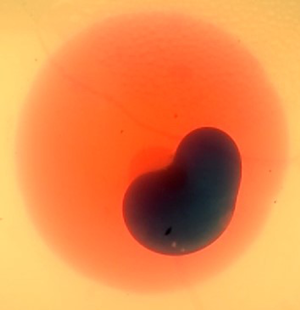Article contents
Axisymmetric displacement flows in fluid-driven fractures
Published online by Cambridge University Press: 15 December 2022
Abstract

Displacement flows are common in hydraulic fracturing, as fracking fluids of different composition are injected sequentially in the fracture. The injection of an immiscible fluid at the centre of a liquid-filled fracture results in the growth of the fracture and the outward displacement of the interface between the two liquids. We study the dynamics of the fluid-driven fracture, which is controlled by the competition between viscous, elastic and toughness-related stresses. We use a model experiment to characterize the dynamics of the fracture for a range of mechanical properties of the fractured material and fracturing fluids. We form the liquid-filled pre-fracture in an elastic brittle matrix of gelatin. The displacing liquid is then injected. We record the radius and aperture of the fracture, and the position of the interface between the two liquids. In a typical experiment, the axisymmetric radial viscous flow is accommodated by the elastic deformation and fracturing of the matrix. We model the coupling between elastic deformation, viscous dissipation and fracture propagation, and recover the two fracturing regimes identified for single-fluid injection. For the viscous-dominated and toughness-dominated regimes, we derive scaling equations that describe the crack growth due to a displacement flow and show the influence of the pre-existing fracture on the crack dynamics through a finite initial volume and an average viscosity of the fluids in the fracture.
- Type
- JFM Papers
- Information
- Copyright
- © The Author(s), 2022. Published by Cambridge University Press
References
REFERENCES
Tanikella and Dressire supplementary movie 1
Time evolution of the pre-fracture formed in experiment 1. The red-dyed oil propagates radially and forms an axisymmetric fracture. The movie is accelerated 50 times.
Tanikella and Dressire supplementary movie 2
Time evolution of the fracture formed in experiment 1. The black-dyed water is injected at the center of the pre-fracture. Both the fracture tip and the interface between the two fluids exhibit an axisymmetric propagation. The movie is accelerated 50 times.
- 6
- Cited by



